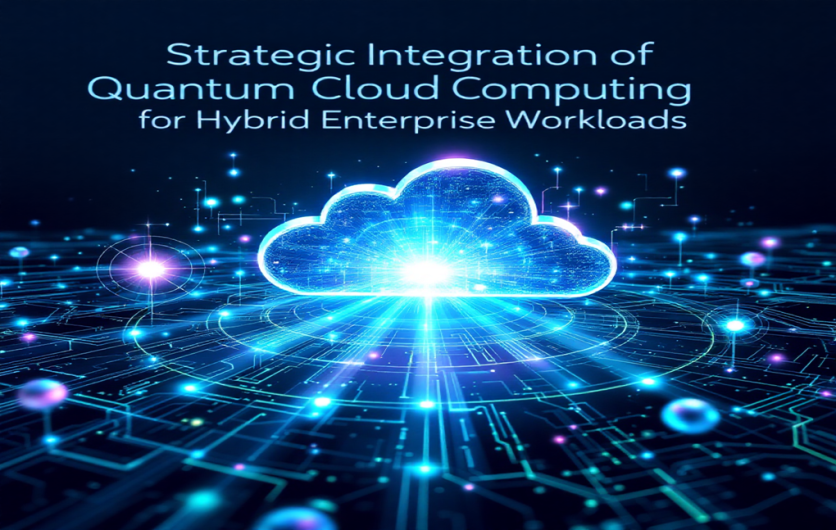
In the age of technology, Clement Praveen Xavier Pakkam Isaac is a seasoned quantum computing researcher with deep insights into emerging computational paradigms. This article explores groundbreaking innovations shaping enterprise quantum adoption strategies.
Rethinking Computation: Where Quantum Meets the Cloud
In an era of escalating computational complexity, traditional systems are rapidly approaching their performance ceilings, limiting innovation across sectors. Quantum Cloud Computing (QCC) emerges as a pivotal shift—melding quantum processing power with scalable, flexible cloud infrastructure. This powerful convergence isn't merely a hardware evolution, but a profound redefinition of how enterprises will approach optimization, simulation, data analytics, and cybersecurity. By enabling access to previously unattainable computational speeds and capabilities, this shift represents a transformative leap toward solving intricate, multidimensional problems once deemed intractable, unlocking new frontiers in enterprise intelligence and decision-making.
The QCHAM Framework: Structuring the Future
At the heart of this transformation is the Quantum-Cloud Hybrid Adoption Model (QCHAM). Designed as a layered framework, it guides enterprises through three critical domains: Quantum Computing-as-a-Service (QCaaS), Hybrid Quantum-Classical Orchestration (HQCO), and Quantum-Resilient Security (QRS). Each layer addresses core challenges in accessibility, performance, and cryptographic security. Instead of jumping headfirst into quantum adoption, QCHAM enables a strategic, phased integration within existing ecosystems.
Layer One: Democratizing Quantum Access
Quantum Computing-as-a-Service (QCaaS) brings advanced quantum capabilities to organizations without the need for dedicated, costly infrastructure. Leveraging cloud interfaces and unified APIs, it abstracts the underlying hardware complexities and delivers scalable, on-demand access to quantum processors. This empowers developers to run quantum jobs seamlessly across diverse platforms using familiar tools and programming environments. Crucially, QCaaS also includes intelligent resource management, job scheduling, and result integration features—bridging quantum outputs with classical systems in a digestible, actionable format, while enabling efficient orchestration and improved workflow continuity within existing enterprise ecosystems.
Layer Two: Orchestrating Hybrid Intelligence
While quantum processors offer speed in niche areas, classical systems still hold the fort in data preparation and post-processing. The HQCO layer optimizes this hybrid dynamic by intelligently distributing workloads. Sophisticated tools identify computational bottlenecks, optimize quantum circuits, and unify development environments. This ensures quantum and classical systems operate not in silos, but as a synchronized unit that maximizes performance and minimizes latency.
Layer Three: Future-Proofing Enterprise Security
With the rise of quantum comes the fall of traditional cryptography. QRS anticipates this vulnerability by embedding post-quantum cryptographic standards and quantum key distribution mechanisms into enterprise security frameworks. Automated tools scan for outdated encryption, while policies ensure compliance with evolving threats. This proactive approach transforms security from a static shield into a dynamic, quantum-aware defense system.
Simulation First: Building Confidence Before Commitment
Enterprises can now use advanced simulators to test quantum algorithms before deploying them on real hardware. Platforms like IBM's Qiskit Aer and NVIDIA's cuQuantum simulate up to 100 qubits, helping organizations prototype effectively. This step eliminates blind investments and fosters confidence in quantum viability—essential for informed decision-making during early adoption stages.
A Strategic Path to Quantum Integration
Quantum adoption is best navigated through a four-phase roadmap: assessment, pilot implementation, production integration, and advantage realization. This journey demands not only technological readiness but also executive sponsorship and workforce upskilling. Early phases emphasize identifying bottlenecks and launching pilot programs, while later stages focus on scaling successful implementations and deploying quantum-native applications.
Cost, Complexity, and Commitment
Quantum cloud services vary significantly in pricing and architecture. Whether through pay-per-use models or subscription tiers, understanding the economics is crucial. Furthermore, challenges in integration, governance, and talent acquisition often slow progress. The path forward requires not just investment in systems, but also in cross-functional collaboration and quantum literacy.
A Call for Collaborative Quantum Progress
To harness the full potential of quantum, public-private partnerships and standardization efforts must accelerate. Industry, academia, and governments need to converge on open-source development, workforce training, and ethical frameworks. These collaborations will not only speed innovation but also ensure broad-based access to quantum benefits.
In conclusion, by navigating the nuanced interplay between classical and quantum resources, the QCHAM framework offers a sustainable path toward enterprise transformation. As quantum systems continue to evolve, the organizations that begin building quantum fluency today will lead tomorrow's innovation frontier. Clement Praveen Xavier Pakkam Isaac leaves us with a clear message: the future of enterprise computing is not purely quantum or classical—it is unequivocally hybrid.
ⓒ 2025 TECHTIMES.com All rights reserved. Do not reproduce without permission.





